SPLINTERS
Tennessee Valley Woodworkers
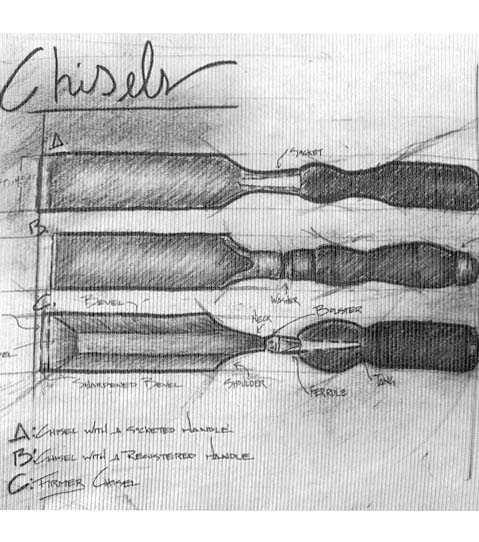 Vol. 17/ Issue 11 November
2002 Editor: Tom Gillard
Jr.
Vol. 17/ Issue 11 November
2002 Editor: Tom Gillard
Jr. 

Meeting Notice:
The next meeting of the TN Valley Woodworkers
Will be held, November 19th, at 7:00 p.m. in the
Duck River Electric Building, Decherd, TN
All interested woodworkers are invited!

 The following people have agreed to serve as contacts for their particular
skills. If you have questions, suggestions for activities, or other
comments relating to these skills, please call these folks. Their
interest is to help the club better serve their area of expertise.
Your participation with them will help them achieve that goal.
The following people have agreed to serve as contacts for their particular
skills. If you have questions, suggestions for activities, or other
comments relating to these skills, please call these folks. Their
interest is to help the club better serve their area of expertise.
Your participation with them will help them achieve that goal.
Alice
Berry 454-3815 Design
Phil Bishop
967-4626 Finishing
Tom
Church 967-4460 Turning
Harry May
962-0215 Carving
Bob
Reese 728-7974 Sharpening
Ross Roepke
455-9140 Joinery
Maurice Ryan 962-1555 Health and Safety
List of
Club Officers
President: Bob Leonard
V. President: Doyle McConnell
Secretary: Barbara Keen
Treasurer: Henry Davis
Publicity: Maurice & Ruth Ryan
Newsletter Editor: Tom Gillard Jr.
GOD BLESS AMERICA!

We are getting a new home for the newsletter...
Richard Gulley is spearheading this effort in hopes that we can catalog
more of the things that we woodworkers like. Nothing else about the newsletter
will change. Click HERE to go
to the new address for all things concerning the Tennessee Valley
Woodworkers.
Thanks,
CALENDAR of EVENTS
- Christmas Potluck - December 6th at the First Church of the Nazarene
Fellowship Hall, address: (4th & Cumberland). I'm
sure we'll discuss the Christmas pot-luck at our next meeting. We've been
asked to bring a little something from the shop to use for door prizes
- Look around and see what you have. We'll also need to know how many to
plan for, so take a count of family and guests that are planning to attend.
We'll try to get a total at the November meeting.
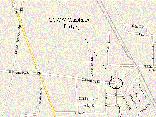
The November meeting will be a program by Tom Gillard on
glue. This presentation is to complement the joinery theme we have
covered this year. Tom is a professional woodworker and owner of Branching
Out a Tullahoma business.
Elections are coming up soon!
If the nominating committee calls you and asks you to serve, PLEASE consider
it. They wouldn't have asked you if they didn't believe you would
do a good job.
ANNOUNCEMENTS: Steve Savelle said that he had gotten a lot of
basswood from a friend and anyone that could use some should contact him
Yesterday's Tools: Crown Molder
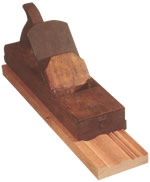
This yellow birch crown molder dates back to the late 1700s. A furnituremaker
probably used molding of this size and style.
Craftsmanship was on the rise in the prosperous English colonies of
North America by the middle of the 18th century. Many colonists, enjoying
affluence after struggling to civilize the new world, sought more refined
surroundings.
Colonial carpenters and furnituremakers obliged them with English-style
work, featuring ornate moldings. The largest were crown and cornice moldings.
Crown molding fits on an angle across the junction of the wall and ceiling
inside a building; cornice molding, where the roof overhang meets the outside
wall. Similar moldings also graced cabinetry and even picture frames.
To make these fancy moldings, carpenters and furnituremakers used crown
molders—sometimes called cornice planes—like the one shown above. The crown
molder's curvaceous blade usually measured 3–4" wide, but some were as
wide as 8". The blade of the crown molder shown measures 3-1/8" wide. The
plane's body is 3-1/2" wide and 12" long.
In practice, woodworkers didn't start on flat stock with these wide
planes. The general form of the molding would be roughed out first, using
adzes, gouges, and smaller molding planes. Only then would the craftsman
bring out his big crown molder.
As often as not, a master and apprentice would team up to plow the wide,
deep blade through the wood. The master guided the plane as the apprentice
tugged on a rope tied to an eye screwed into the plane's front. (Though
the eye is long gone from the plane in the photo, you can see the hole
for it in the front of the plane.) Though it sounds simple, the actual
procedure was anything but a romp in the shop. Often, the planing was accompanied
by much hot-tempered give-and-take between the master and his apprentice.
Surviving crown molders date as far back as the mid-1700s. Some were
made as late as the 1890s, but machine-milled moldings, which became common
after the Civil War, finally ended the reign of the crown molders.
Because cornice planes and crown molders were tools of master craftsmen,
they were uncommon items. That also means most didn't suffer neglect and
abuse, so surviving tools are often in very good condition.
Today, collectors covet these fancy molding planes. "Marked 18th century
models can be worth $2,000–$3,000," according to antique-tool collector
and dealer Philip Whitby. "A pair of early Philadephia crown molders, one
with a blade more than 6" wide and the other more than 7", sold lately
for $10,000," he reports.
(Wood On-line:
http://www.woodmagazine.com//11-1-02.html)
SHOW AND TELL:
Jim Van Cleave brought a Walnut table for maps that he put together
to show how it was done.
Richard Gulley brought wooden spoons he had made, 2 of which were put
together with a wooden chain with each of his daughters names on them.
Tom Gillard Jr. showed a turned pen that were a gift for the Boy Scout
adult training course. There were 80-85 made. He also showed an octagon
top of a game table he made out of quarter-sawed oak with a tar stain and
a checkerboard in the center.
Loyd Ackerman brought a lamented curve piece that was made out of 5
– 1/8 inch pieces of door skin and with veneer lamented on each side.
He said it was from a program Ray Cole had given on curved pieces about
7 years ago. He also showed a box he made out of Mahogany and said
he found out the hard way that you have to lower your pressure on pneumatic
guns when using on Mahogany or they would blow a hole through the piece
as he did.
Harold Hewgley showed a chip and dip bowl he made out of Cherry and
sprayed with a water based acrylic.
Henry Davis made a keepsake box that had a drawer in it and was made
out of maple with a spalted maple top. The lid has a space for letters
or pictures.
Bob Beswetherick brought back his finished Mandolin made out of Spruce
for the top, Canary wood, yellow heart, purple heart and popular.
He finished with Tongue oil. The second Mandolin he brought in was
made out of spruce, popular, African mahogany, yellow heart, Purple Heart
and canary wood. He has 100 hours in each instrument.
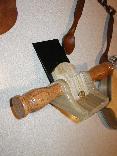 Dave Whyte made 2 holders
for
scrappers. He made the brass adjustment by using a ¼-20 screw
and epoxy on a brass knob. They were made out of oak and as usual they
were both functional and pleasing to the eye.
Dave Whyte made 2 holders
for
scrappers. He made the brass adjustment by using a ¼-20 screw
and epoxy on a brass knob. They were made out of oak and as usual they
were both functional and pleasing to the eye.
John Brewster our newest member turned a bowl out of cherry. He
also made a bowl out of Dogwood.
Karen Kerce turned a bowl out of spalted maple and another out of Cedar
that would have been firewood if she had not rescued it.
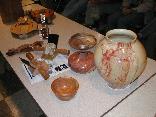 Doyle showed
a vase he had turned out of Box Elder. The finish was gloss polyurethane
thinned with Mineral Spirits 60/40 and wiped on while lathe was turning.
He let dry between coats
Doyle showed
a vase he had turned out of Box Elder. The finish was gloss polyurethane
thinned with Mineral Spirits 60/40 and wiped on while lathe was turning.
He let dry between coats
John Mayberry made a stool out of cherry for his daughter and he weaved
the seat at the fair.
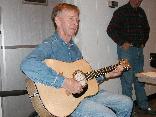 John Sargent brought
in a guitar he made from a kit. It was Rosewood, Spruce, Ebony, and
Mahogany. A second guitar was shown that was made by Earl George
completely out of maple
John Sargent brought
in a guitar he made from a kit. It was Rosewood, Spruce, Ebony, and
Mahogany. A second guitar was shown that was made by Earl George
completely out of maple
Sweet Gum
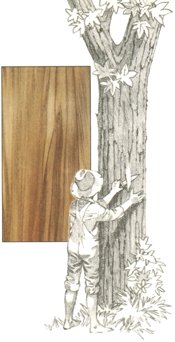
In the old days, youngsters throughout the rural South went to the
woods, not the grocery store, for their chewing gum. There, they sought
out a tree with unusual star-shaped leaves and bark resembling alligator
skin. From it they pried off, then popped into their mouths, yellowish
brown balls of a fragrant, resinous substance with a licorice-like taste.
Their treat was the sap of the native sweet gum tree (Liquidambar styraciflua).
Little did they know that this natural confection, called liquidambar,
had been in demand for centuries.
As reported by historians traveling with the explorer Cortes in 16th-century
Mexico, the Aztec emperor Montezuma relaxed by puffing a cane stuffed with
a mixture of tobacco and a flavoring of liquidambar from a tropical variety
of sweet gum. But even before that, in Europe, liquidambar was obtained
through Asian traders for use in perfume, incense, and for treating diphtheria
and flatulence.
Despite the world demand for liquidambar through the centuries, little
was done with the yield of the North American sweet gum tree. It did serve
as a curative for Confederate soldiers' dysentery, and was harvested during
the Second World War when Asian supplies were cut off.
Sweet gum wood, though, has been another story. The often beautifully
figured stock can resemble walnut. And when quartersawn, it passes as the
costly Circassian walnut fancied for fine furniture and gunstocks.
(Wood Online)
FOR SALE
Craftsman 10 in. Table Saw $250.00
Craftsman Wood Shaper $175.00
14 Shaper Cutters $100.00
Central Machinery 8 in. grinder $75.00
Contact Henry Davis
393-3191
FOR SALE:
12” Sears Wood Turning Lathe.
36” between centers, ½ hp motor, 4 speeds;
Comes with the following items:
6” & 12” tool rest, 4” faceplate, table and a speed reduction
assembly.
$150.00
Contact Tom Gillard (455-6651
or 393-0525)
FOR SALE:
Heavy duty wood turning lathe, 18 3/4" swing, 35" between centers,
made by J.A. Fay in
Cincinnati in early 1900's, on heavy timber frame, 3/4 hp single
phase motor,
3 different length tool rests, two faceplates, can be rigged for
outboard turning, labor intensive, not for sissies,
$250.00
Contact: Jim Van Cleave
455-8150

WEB
SITES of INTEREST
Members sites:
Resourse Sites:


The Leitz Tooling Systems has moved to Muscle Shoals, AL but
will still do the sharpening. The blades will have to be shipped
UPS as the
salesman doesn't call on me as much now that the company has moved.
This cost will have to be passed along. Sorry.
Call (393-0525) or stop by for details.
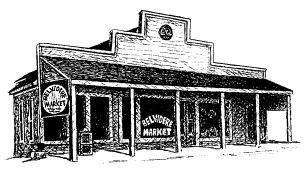
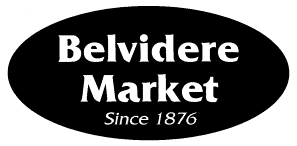
10 % OFF Fine Woodworking
Books from Taunton Press
…We’re open Monday thru Saturday
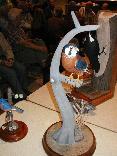
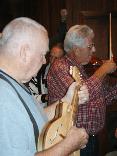
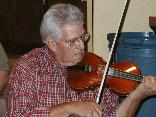
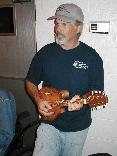

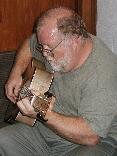
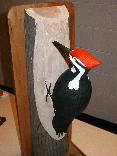
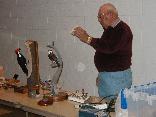
SEE YOU ON THE
19th!
Webmaster:
Tom Gillard Jr.

 Vol. 17/ Issue 11 November
2002 Editor: Tom Gillard
Jr.
Vol. 17/ Issue 11 November
2002 Editor: Tom Gillard
Jr. 



 Dave Whyte made 2 holders
for
scrappers. He made the brass adjustment by using a ¼-20 screw
and epoxy on a brass knob. They were made out of oak and as usual they
were both functional and pleasing to the eye.
Dave Whyte made 2 holders
for
scrappers. He made the brass adjustment by using a ¼-20 screw
and epoxy on a brass knob. They were made out of oak and as usual they
were both functional and pleasing to the eye.
 Doyle showed
a vase he had turned out of Box Elder. The finish was gloss polyurethane
thinned with Mineral Spirits 60/40 and wiped on while lathe was turning.
He let dry between coats
Doyle showed
a vase he had turned out of Box Elder. The finish was gloss polyurethane
thinned with Mineral Spirits 60/40 and wiped on while lathe was turning.
He let dry between coats
 John Sargent brought
in a guitar he made from a kit. It was Rosewood, Spruce, Ebony, and
Mahogany. A second guitar was shown that was made by Earl George
completely out of maple
John Sargent brought
in a guitar he made from a kit. It was Rosewood, Spruce, Ebony, and
Mahogany. A second guitar was shown that was made by Earl George
completely out of maple









